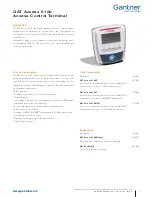
Additional Commands
The commands VS n, VA n, and VD n are used to specify the vector speed, acceleration and deceleration. The
DMC-40x0 computes the vector speed based on the axes specified in the LM mode. For example, LM XYZ
designates linear interpolation for the X,Y and Z axes. The vector speed for this example would be computed using
the equation:
VS2=XS2+YS2+ZS2, where XS, YS and ZS are the speed of the X,Y and Z axes.
The controller always uses the axis specifications from LM, not LI, to compute the speed.
IT is used to set the S-curve smoothing constant for coordinated moves. The command AV n is the ‘After Vector’
trippoint, which halts program execution until the vector distance of n has been reached.
An Example of Linear Interpolation Motion:
#LMOVE
label
DP 0,0
Define position of X and Y axes to be 0
LMXY
Define linear mode between X and Y axes.
LI 5000,0
Specify first linear segment
LI 0,5000
Specify second linear segment
LE
End linear segments
VS 4000
Specify vector speed
BGS
Begin motion sequence
AV 4000
Set trippoint to wait until vector distance of 4000 is reached
VS 1000
Change vector speed
AV 5000
Set trippoint to wait until vector distance of 5000 is reached
VS 4000
Change vector speed
EN
Program end
In this example, the XY system is required to perform a 90
°
turn. In order to slow the speed around the corner, we
use the AV 4000 trippoint, which slows the speed to 1000 count/s. Once the motors reach the corner, the speed is
increased back to 4000 cts / s.
Specifying Vector Speed for Each Segment
The instruction VS has an immediate effect and, therefore, must be given at the required time. In some applications,
such as CNC, it is necessary to attach various speeds to different motion segments. This can be done by two
functions: < n and > m
For example:LI x,y,z,w < n >m
The first command, < n, is equivalent to commanding VSn at the start of the given segment and will cause an
acceleration toward the new commanded speeds, subjects to the other constraints.
The second function, > m, requires the vector speed to reach the value m at the end of the segment. Note that the
function > m may start the deceleration within the given segment or during previous segments, as needed to meet the
final speed requirement, under the given values of VA and VD.
Note, however, that the controller works with one > m command at a time. As a consequence, one function may be
masked by another. For example, if the function >100000 is followed by >5000, and the distance for deceleration is
not sufficient, the second condition will not be met. The controller will attempt to lower the speed to 5000, but will
reach that at a different point.
As an example, consider the following program.
#ALT
Label for alternative program
DP 0,0
Define Position of X and Y axis to be 0
LMXY
Define linear mode between X and Y axes.
LI 4000,0 <4000 >1000
Specify first linear segment with a vector speed of 4000 and end speed 1000
Chapter 6 Programming Motion
•
87
DMC-40x0 User Manual
Summary of Contents for DMC-4040
Page 54: ...Chapter 3 Connecting Hardware 45 DMC 40x0 User Manual...
Page 55: ...DMC 40x0 User Manual Chapter 3 Connecting Hardware 46...
Page 56: ...Chapter 3 Connecting Hardware 47 DMC 40x0 User Manual...
Page 73: ...Figure 4 1 GalilTools DMC 40x0 User Manual Chapter 4 Software Tools and Communication 64...
Page 185: ...THIS PAGE LEFT BLANK INTENTIONALLY DMC 40x0 User Manual Chapter 7 Application Programming 176...
Page 205: ...THIS PAGE LEFT BLANK INTENTIONALLY DMC 40x0 User Manual Chapter 10 Theory of Operation 196...
Page 222: ...Step 2 Remove ICM s Appendices 213 DMC 40x0 User Manual...
Page 232: ...DMC 4080 Steps 4 and 5 Step 4 Replace ICM s Appendices 223 DMC 40x0 User Manual...
















































